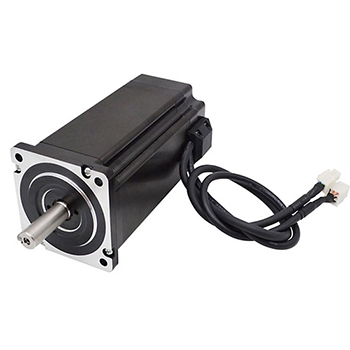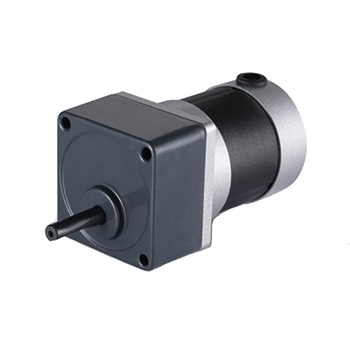DC Gear Motor & Stepper Motor: What are Their Differences?
Whether in life or in industrial life, the use of motors is inseparable. In order to meet the needs of different industries, more and more types have gradually appeared on the market. But many users do not know how to choose when purchasing. In fact, to choose the right product, we must first compare different products. Let's take a look at the difference between a DC geared motor and a stepper motor.
Different definitions
What is stepper motor?
- The stepper motor converts the electric pulse signal into angular displacement or linear displacement. In the case of no overload, the speed and stop position of the motor only depend on the frequency and number of pulses of the pulse signal, and are not affected by load changes. The DC gear motor consists of a reducer (gearbox) + motor. The motor provides high speed, but low torque and high inertia. The function of the reducer is to reduce the speed, increase the torque, and reduce the inertia to achieve the ideal speed and torque.
- When using a stepper motor, precise control of the rotation angle is required. For example, 3D printers and engraving machines can process high-precision models by controlling the displacement of the nozzle (engraving tool) through the rotation angle of the stepping motor. Because there is a gearbox inside the DC gear motor, it can convert high speed and low torque into low speed and high torque.

- Although the DC gear motor can control the rotation angle by controlling the power-on time, when the motor encounters different resistances, the rotation angle per unit time is still different, which is fundamentally different from the stepper motor. A stepper motor does not rotate in a continuous manner, but moves in discrete steps, or increments. Stepper motors are ideal for applications that require precise positioning and repeatability, as well as fast response to starting, stopping, reversing, speed control, holding torque, and low acceleration.
- Another key feature of a stepper motor is its ability to hold a steady load once it reaches the desired position. They are widely used in industrial control applications. In a stepper motor, the input is in the form of electrical pulses and the output is in the form of mechanical motion, which is inherently unobtrusive. It provides control as an advantage over mechanical power generation and should be used if accuracy is a major concern.
What is DC gear motor?
- DC motor is an important part of industrial production. With different application scenarios, there are many different types of motors, which can be selected according to operation, voltage and application conditions. Motor devices can be found in applications ranging from video cameras to fans to DVD players.
- DC gear motor refers to a rotating motor that can convert DC electrical energy into mechanical energy, or convert mechanical energy into DC electrical energy. It is a motor that can convert DC electric energy and mechanical energy into each other. When it operates as a motor, it is a DC motor, which converts electrical energy into mechanical energy; when it operates as a generator, it is a DC generator, which converts mechanical energy into electrical energy.
- There is a ring-shaped permanent magnet fixed inside the DC motor, and the current passes through the coil on the rotor to generate ampere force. When the coil on the rotor is parallel to the magnetic field, the brushes at the end of the rotor are in contact with the switching plates alternately, so the direction of the current on the coil also changes, and the direction of the generated Lorentz force remains unchanged, so the motor can keep rotating in one direction.
 The working principle of the DC generator is to convert the AC electromotive force induced in the armature coil to the DC electromotive force when it is drawn out from the brush end by the commutator and the commutation effect of the brush.
The working principle of the DC generator is to convert the AC electromotive force induced in the armature coil to the DC electromotive force when it is drawn out from the brush end by the commutator and the commutation effect of the brush. - The direction of the induced electromotive force is determined according to the right-hand rule (the magnetic field line points to the palm of the hand, the thumb points to the movement direction of the conductor, and the direction of the other four fingers is the direction of the induced electromotive force in the conductor). The direction of the force acting on the conductor is determined by the left-hand rule. This pair of electromagnetic forces forms a torque acting on the armature. This torque is called electromagnetic torque in the rotating motor. The direction of the torque is counterclockwise, trying to make the armature rotate counterclockwise. If this electromagnetic torque can overcome the resistance torque on the armature (such as resistance torque caused by friction and other load torque), the armature can rotate counterclockwise.
Other different factors
Efficiency: Whenever the stator poles are energized, the stepper motor will consume current at maximum load, reducing energy utilization and heat loss. So, stepping motors are not the best choice if efficiency is considered. But DC motors are a mature technology and can achieve efficiencies of around 85%, which is good for such a simple motor.
Applications: Stepper motors are often used in 3D printers, CNC machinery, medical imaging machines, printers, cameras, and other precision control applications. While DC motors can be used in areas such as telephone vibrators, power tools, car windows, cranes, and conveyor belts, as well as priority applications.
Structure:
- Stepper motor: It is driven by a set of coils wound on the fixed part of the motor - the stator slot.
- DC motor: The rotor part of the DC motor is composed of armature core, armature, commutator and other devices.

